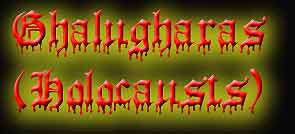
In the days of persecution of Sikhs by the Mughal forces, bonds of Sikhs moved from place to place to find food and shel-ter. A band, composed of about 2000 Sikhs, came to Emnabad to visit Rori Saheb, a place sacred to the memory of Guru Nanak Dev Ji. The Sikhs had not had food for a few days. They addressed a letter to Jaspat Rae, Faujdar of Emnabad, for per-mission to purchase provisions from his town. But the hot-tempered Faujdar, who was an active opponent of Sikhs, ordered them to move away immediately. The Sikhs represented that they had been without food for several days and that they would only stay for the night to feed themselves, and then they would depart. Enraged, Jaspat Rae would not listen to them and fell upon them with all the forces he had with him. The Sikhs offered stiff resistance and one of them, Nirbhau Singh, a Rangretta Sikh, climbed up onto Jaspat Rae's ele-phant and chopped his head off. Finding their leader dead, the Mughal forces were thrown into disarray. The Sikhs fell upon the town of Emnabad and carried away with them much booty.
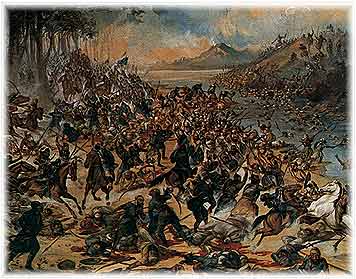
Lakhpat Rae, the brother of Jaspat Rae and the Diwan of the Governor of Lahore,
was inflamed with rage by this incident. He vowed that he would not call himself
the son of a Khatri until he destroyed all Sikhs, branch and root. Yahiya
Khan, the Gover-nor of Lahore, was waiting for just such an opportunity. Lakhpat
Rae got a general proclamation issued for the extirpation of Sikhs. To begin
with, all the Sikh men, women, and children living in Lahore were arrested
from their homes and were merci-lessly murdered on March 10, 1746. Not one
of the thousands of men, women, or children abandoned their faith to save
their life. A huge army, scouring the entire coun-tryside in search of Sikhs,
was under the personal command of Yahiya Khan and Lakhpat Rae. The Sikhs,
about 1 5,000 in number, had taken refuge in the reedy marshes of Kahnuwan.
They were hounded out of their hideouts by the armed Mughals, and forced to
proceed towards the Ravi River. Food and ammunition were both exhausted, and
the Ravi was in flood and could not be easily crossed by their half-starved
horses. In utter desperation, those on foot were asked to escape to the mountains
of Mandi and Kulu, and to rejoin the forces of the Khalsa at Kiratpur. The
main force, under Sukha Singh, pounced upon, and tried to cut through, the
Mughal forces. About two thousand of them were able to cross the river Ravi
and enter the Riarki part of Gurdaspur. It was the begin-ning of June 1746;
to march the long sandy distance on naked, blistering feet, was an unbearable
ordeal. Crossing the river Beas at Sri Hargobindpur and the river Satluj at
Atwal, the Sikhs escaped into Malwa. At least 7,000 Sikh men were killed in
this campaign. Another 3,000 Sikhs were arrested and brought to Lahore for
execu-tion. Their heads were piled up to make pyr-amids and their bodies buried
under the walls of a mosque.
In 1762, the Sikhs suffered a bigger holocaust (wadda Ghalu-ghara). Hence,
this episode came to be known as Chhota Ghalughara, the lesser holocaust.
But suffering did not cow down the Sikhs' spirit, in-stead it inspired them
to bid for sovereign power.
Wadda Ghalughara (The Great Holocaust)
After defeating the Afghan Viceroy of Lahore, Khwaja Ubaid Khan, at Gujranwala,
the Sikhs then entered Lahore, led by Jassa Singh Ahluwalia. By the end of
1761, the entire Panjab from the Satluj to the Indus passed into the hands
of Sikhs, with only a few refractors still holding out in the name of Ahmad
Shah Abdali. The Sarbat Khalsa gathered at Amritsar on the festival of Diwali
on October 27,1761. They passed a Gurmatta to reduce the strongholds of Ahmad
Shah's allies, as they were a hindrance to the liberation of the Panjab. First
of all, the Khalsa decided to deal with Aqil Das of Jandiala, the leader of
the Niranjanias. They laid siege on Jandiala.
Ahmad Shah Abdali, who was already on his way to India to deal with the rise
of Sikh power, received a request for help from Aqil Das. Ahmad Shah rushed
to Jandiala, but found that the Sikhs had already raised their siege and left.
When he returned to Lahore, he received information from the Afghan chief,
Bhikhan Khan of Malerkotla, that a large Sikh force had gathered near Kup,
close to Malerkotla. With a light cav-alry force, Ahmad Shah left Lahore on
February 3,1762, and covering a distance of about 200 kilometres by his rapid
marches, reached near Malerkotla on the early morning of February 5, 1762.
The Shah divided his army into three parts; one under his personal charge,
the second un-der Shah VaIi Khan, and the third under Jahan Khan. About 50,000
Sikhs were en-camped with their families near Malerkotla. The Shah had already
sent instructions to Zain Khan, the Governor of Sarhind, to march out with
all his troops and meet Vail Khan near Malerkotla to deliver an attack
from the front, covering the two flanks of the Sikhs. The Shah had also informed
Zain Khan that his and Jahan Khan's forces would attack from the rear covering
both the flanks from behind.
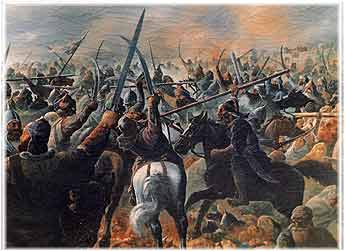
On the morning of February 5,1762, the Sikhs were attacked on all four sides.
They were taken by surprise; several thousand Sikhs, mostly women and children,
were killed. The Sikh leaders at once decided on the plan of action. One group
threw a strong cordon around the bahir (remaining women, children, and their
baggage) and moved on, fighting against the enemy. In front of this group,
Misaldars Jassa Singh AhIuwalia, Charat Singh Sukarchakla, and Sham Singh
Karorsinghia led the main army of about 40,000 combatant Sikhs. They fought
fervently with unsurpassed bravery, dogged tenacity, and invincible fortitude.
They pushed along, fighting from village to village. Their aim was to reach
Barnala, where they hoped to find some relief with Baba Ala Singh, failing
which, they could pass onto the waterless deserts of Bhathinda.
However, before they could reach Barnala, Ahmad Shah Abdali's forces made
a wedge between the main Sikh army and the following cordon around the bahir.
A wholesale massacre of Sikhs ensued. The main Sikh army was separated from
the bahir, whose men, women, and children were mercilessly butchered. The
main Sikh army now continued their retreat at a greater speed. Ahmad Shah
continued the pursuit as far as Barnala, 40 kilometres from Kup. This bloody
carnage, in which about 20,000 Sikhs lost their lives, is known as the Wadda
Ghalu-ghara (Great Holocaust) in Sikh history.
The Nankana Holocaust
Gurdwara Janam Asthan, Nankana Saheb, is the birthplace of Guru Nanak Dev
Ji. This gurdwara was the most richly endowed gurdwara because of its land
revenue and the generous offerings it received. At one time an Udasi Mahant,
Narain Das, managed it. He lived in the gurdwara with a mistress, drank liquor,
and was known to have invited prostitutes to dance in the sacred precincts.
The local Sikhs held a meeting at Dharowal in October 1920 and passed a reso-lution
calling upon the mahant to reform himself. But, instead of doing anything
to remove the grievances of the public, Mahant Narain Das asked for police
protection and began to make preparations for violence. He hired about 400
thugs, including some Pathans, and armed them with axes and firearms to deal
with those who might come to seize the gurdwara. In October 1920, Lachhman
Singh Dharowalia went with a few devotees to pay respects in the gurdwara.
The thugs hired by the Mahant set upon them. But violence was averted by timely
in-tervention of the police.
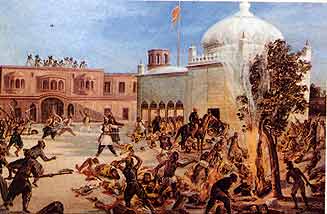
Lachhman Singh Dharowalia announced his intention of going with a jatha (group)
of Sikhs in the morning of February 20, 1921. Apprehending that there might
be violence in the gurdwara, the situation at Nankana Saheb attracted the
atten-tion of the authorities. On February 16, 1921 the government tried to
resolve the issue by inviting both parties to a conference. This however,
did not produce any positive results.
Lachhman Singh Dharowalia started on February 19, 1921, from his town with
a jatha of 23 Sikhs. More Sikhs joined them on the way. By the time they reached
near Nankana Saheb, the number of Sikhs had grown to about 150. On the morning
of February 20, 1921, the whole jatha took a vow of non-violence and entered
Gurd-wara Janam Asthan. Narain Das's thugs closed the gates behind them and
attacked the jatha with swords, hatchets, and firearms. The dead and dying
Sikhs were then dragged to a pile of logs and burned. Some of them were hanged
on trees upside down and burned alive By the time the police and the local
Sikhs arrived on the scene, 130 Sikhs had been consumed by fire.
The news spread like wildfire. Bands of Sikhs converged at Nankana Saheb.
The Lieutenant Governor, who had arrived with a unit of British soldiers,
arrested Mahant Narain Das and his thugs. He handed over the keys of the gurdwara
to the Sikhs representing the scpc~ Later, Mahatma Gandhi visited Nankana
Saheb and said: "Everything points to a second edition of Dyerism, more
barbarous and more fiendish than the barbarism at Jallianwala." Sikhs
were asked by SGPC to wear black turbans in remem-brance of the martyrs of
this tragedy at Nankana Saheb.
For the murder of the 130 Sikhs, three men were sentenced to death and two,
including Narain Das, to transportation for life.
Atrocities at Guru Ka Bagh
Guru ka Bagh (the garden of the Guru) is a gurdwara located about thirteen
miles from Amritsar, built to commemorate a visit made by Guru Arjan Dev ji.
Near the gurdwara is a plot of land from which acacia trees provide firewood
for guru-ka-langar. Udasi Mahant Sundar Das received Amrit and agreed to work
under an elected committee of Sikhs. Then, without any apparent cause, in
the first week of August 1922 he lodged a complaint that the Sikhs were cut-ting
timber from the gurdwara land. On August 8, 1922, five Sikhs who were cutting
timber were charged with criminal trespass and arrested by the police. The
Akali leaders then held a meeting at Guru ka Bagh in spite of the Seditious
Meeting Act being in force. The police dispersed the meet-ing and arrested
the Akali leaders, including Mehtab Singh and Master Tara Singh.
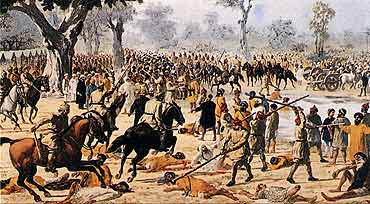
These merciless beatings continued every day in the presence of hundreds
of people. The media reporters photographed the harrowing scenes and published
them in India and foreign coun-tries. The news stirred the conscience
of people at large. An Englishman by the name C.E Andrews visited the
scene of agitation at Guru ka Bagh. He was deeply moved by the noble "Christ-like"
behavior of the Sikhs. He apprised Sir Edward Maclagan, the Lieutenant
Governor of Punjab, of the brutality of the police and requested him to
see things for himself. Sir Edward Maclagan ar-rived at Guru ka Bagh on
September 13, 1922, and was affected by the atrocities being committed
on the peaceful Sikhs. He immediately ordered the beating to stop. However,
the arrests of Sikhs, who still came in jathas of 100 everyday, continued.
At last, Sir Ganga Ram, a retired engineer, came forward to save the government
embarrass-ment. He bought the land in dispute from the Mahant and handed
it over to the S G PC on November 17, 1922. The arrests stopped and the
Sikhs were allowed to go free to the gurdwara and cut wood from its land.
By the end of the agitation on November 17, 1922, 5605 Sikhs had been
arrested and 936 were hospitalized.
The English Superintendent of police, S.G.M. Beaty, was responsible for merciless
beatings of peacefully demonstrating Sikhs. He came to be known as a notorious
Sikh-baiter. After the end of the Akali Movement, a Babbar Akali assassinated
him in the state of Patiala.(courtesy Dr. Santokh Singh-"The Guru's Word")